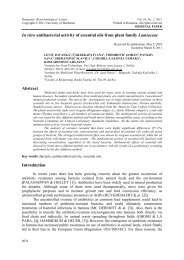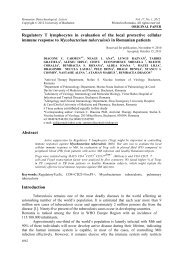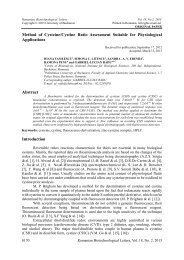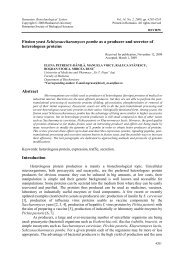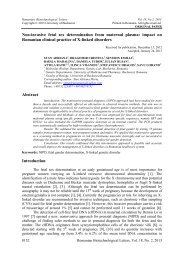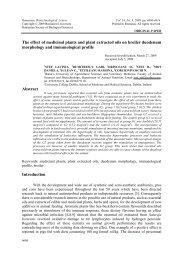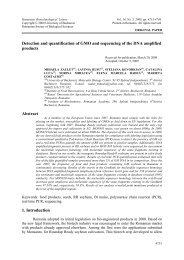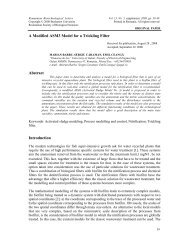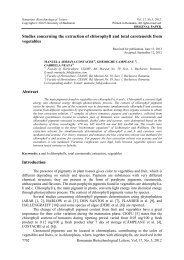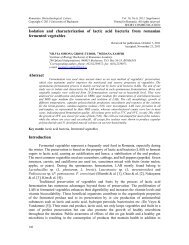Soilless Culture Production of Alecost ... - ResearchGate
Soilless Culture Production of Alecost ... - ResearchGate
Soilless Culture Production of Alecost ... - ResearchGate
Create successful ePaper yourself
Turn your PDF publications into a flip-book with our unique Google optimized e-Paper software.
M.B. HASSANPOURAGHDAM, S. J. TABATABAEI, M.A. AAZAMI and F. SHEKARI[9,10,11]. <strong>Soilless</strong> culture production <strong>of</strong> plants especially medicinal herbs has many valuableadvantages such as: high yields, cleaner production, year-long cultivation, and production <strong>of</strong>drugs with minimum herbicide and pesticide residues [12,13]. Suitable and adequate supply<strong>of</strong> water, air, and nutrient elements, thereafter increase in absorptive and metabolic potential<strong>of</strong> roots and subsequently higher production <strong>of</strong> aerial and underground parts are the mainadvantages <strong>of</strong> this production systems compared with field grown counterparts [3,12,14,15].In a series <strong>of</strong> experiments on the assessment <strong>of</strong> growth and cultural requirements <strong>of</strong> alecost,we tried to evaluate the basic nutritional needs <strong>of</strong> alecost in hydroponic system. To the best <strong>of</strong>our knowledge there is no previous report on the soilless culture production <strong>of</strong> alecost.The aim <strong>of</strong> the present report was to evaluate for the first time the effects <strong>of</strong> differentlevels <strong>of</strong> N & K and different concentrations <strong>of</strong> nutrient solution on the growth and essentialoil content and yield <strong>of</strong> alecost.Material and MethodsThis experiment was carried out at Research Greenhouse <strong>of</strong> Horticultural SciencesDepartment at the University <strong>of</strong> Tabriz, Iran. Propagation materials were rhizome cuttingssupplied from an established alecost field near Tabriz in Northwest Iran.Growing conditionsThe greenhouse used in these experiments was an one-layer polyethylene covered greenhousewith ambient temperature, light and relative humidity <strong>of</strong> 15-30 0 C, ~400µmolm -2 s -1 and 40-50% respectively. Rhizome cuttings (10cm length×1cm width) were prepared, rinsed with tapwater, disinfected with Benomyl and immediately planted in pots containing medium sizedperlite and vermiculite (8:2 volume: volume).First experimentIn this experiment four concentrations <strong>of</strong> N (100, 200, 300 and 400 mgL -1 ) and twoconcentrations <strong>of</strong> K (100 and 200 mgL -1 ) based on the modified Hoagland's nutrient solutionwere applied on plants. Experimental design was factorial, based on RCBD with threereplications and 8 treatment combinations.Second experimentIn this experiment four concentrations <strong>of</strong> the modified Hoagland's nutrient solution (0.25X,0.5X, 1X and 2X) were used as treatments. Experimental design was randomized completeblock with 6 replications.MeasurementsLeaf area: Leaf area (cm 2 ) <strong>of</strong> plants were measured at the end <strong>of</strong> the growing season, i.e.button stage <strong>of</strong> flowers in last week <strong>of</strong> September, by leaf area meter (Li-Cor, Model Li-1300,USA) and also the fresh weight <strong>of</strong> leaves was recorded. Dry weight <strong>of</strong> leaves was evaluatedafter drying <strong>of</strong> leaves in an air-forced oven at 70 0 C for 72 hrs until constant weight.Essential oil content and yield: Volatile oil content <strong>of</strong> plants was measured through 120 minhydro-distillation <strong>of</strong> 50 grams <strong>of</strong> air-dried aerial parts <strong>of</strong> plants by Clevenger-type apparatus,according to the European pharmacopoeia. Essential oil yield was evaluated by themultiplication <strong>of</strong> essential oil content to the related dry weight <strong>of</strong> plants and reported as mlm -2 .Nutrients content: Nitrogen content (mgg -1 ) <strong>of</strong> plants was measured according to theKjeldahl method. Phosphorus and potassium content were assessed by colorimetric(Vanadate-Molybdate) and flame photometric (CORNING, Series 410, France) methodsrespectively.Data analysisAll data were subjected to variance analysis by SAS 8.02 s<strong>of</strong>tware. Mean comparisons werecarried out by Duncan's multiple range test at P
<strong>Soilless</strong> <strong>Culture</strong> <strong>Production</strong> <strong>of</strong> <strong>Alecost</strong> [Chrysanthemum balsamita (L.) Baill.]: A Preliminary StudyResults and DiscussionTreatment combinations <strong>of</strong> N and K statistically (P
M.B. HASSANPOURAGHDAM, S. J. TABATABAEI, M.A. AAZAMI and F. SHEKARIIn contrast with growth characteristics, the highest tissue N content belonged toN 300 K 100 and N 400 K 100 treatments. This inconsistency between growth characteristics andtissue N content shows that the increased growth in N 200 K 200 treatment caused the nitrogendilution in plant tissues and thereafter reduced tissue N content [18]. Similar results have beenreported by Singh and Singh [19]. For potassium content <strong>of</strong> plant tissue, the best treatmentwas N 200 K 200 . This trend shows that along with growth characteristics, maximum absorptionand assimilation <strong>of</strong> K within plant needs the equal and balanced ratios <strong>of</strong> N and K.Different concentrations <strong>of</strong> nutrient solution had significant effects on fresh and dryweight <strong>of</strong> leaves (P
<strong>Soilless</strong> <strong>Culture</strong> <strong>Production</strong> <strong>of</strong> <strong>Alecost</strong> [Chrysanthemum balsamita (L.) Baill.]: A Preliminary StudyK content. Increase in tissue P and K content with promoting <strong>of</strong> nutrient solutionconcentration is completely reasonable. Udagawa [15] reported that increase in nutrientsolution concentration accompanied increase in K and P content <strong>of</strong> dill and thyme plants. It isnoteworthy that for both P and K, the lowest concentration <strong>of</strong> nutrient solution i.e. 0.25X hadthese nutrients sufficiency and no deficiency symptoms were observed.N and K treatment combinations affected essential oil content and yield <strong>of</strong> costmary(Figure 3).Essential oil contentEssential oil yieldEssential oil content (%Dwt)0.60.50.40.30.20.10N100 K 100bN200 K 100bN300 K 100bN400 K 100bbc bc bc ab c a c abcN100 K 200N200 K 200N300 K 200Treatment combinationsN400 K 200Figure 3. Effects <strong>of</strong> treatment combinations <strong>of</strong> nitrogen and potassium on essential oil content and yield <strong>of</strong> alecost.Different letters show significant difference between treatments based on Duncan's multiple range test at P
M.B. HASSANPOURAGHDAM, S. J. TABATABAEI, M.A. AAZAMI and F. SHEKARIThere was no significant difference between other treatments. The highest essential oilyield was recorded in 0.25X and 1X treatments. Along with growth parameters, 2X treatmenthad the lowest essential oil content and yield as well. The results related to the essential oilcontent and yield implies that alecost has the potential capability <strong>of</strong> essential oil biosynthesisand accumulation under low nutrient solutions concentrations. Suh et al [14] reported that thehighest essential oil content and yield <strong>of</strong> different ocimum varieties related to the lowconcentrations <strong>of</strong> nutrient solution. Udagawa [15] noted that the lowest concentration <strong>of</strong>nutrient solution had the elevated essential oil content in dill plants. It seems that under lownutrient solution concentrations, increased absorptive capacity <strong>of</strong> roots leads to the intensifiedmetabolic and biochemical activities <strong>of</strong> plant and resulted in an increase <strong>of</strong> essential oilproduction.ConclusionIn general, the results obtained from the present experiment showed that accurate andbalanced ratios <strong>of</strong> N and K as well as appropriate concentrations <strong>of</strong> nutrient solution hadencouraging effects on growth parameters and essential oil content and yield <strong>of</strong> alecost.Finally, it seems that successful hydroponics production <strong>of</strong> this high-value medicinal plantcould be a promising message for pharmaceutical and food industries on meeting their highdemands for alecost raw material.References1. V. MOZAFFARIAN, A dictionary <strong>of</strong> Iranian plant names, (Persian). Farhang Moaser PublishingCompany, Iran, 2004, pp. 534-535.2. K. JAIMAND, M.B. REZAEE, Chemical constituents <strong>of</strong> essential oils from Tanacetum balsamita L. ssp.balsamitoides (Schultz-Bip.) Grierson. from Iran, J. Essent. Oil Res., 17, 565-566 (2005).3. M.B. HASSANPOURAGHAM, S.J. TABATABAIE, H. NAZEMIYEH, A. AFLATUNI, N and Knutrition levels affect growth and essential oil content <strong>of</strong> costmary (Tanacetum balsamita L.), J. FoodAgr. Environ., 6, 150-154 (2008).4. E. BYLAITE, R. VENSCUTONIS, J.P. ROOZEN, M.A. POSTHUMUS, Composition <strong>of</strong> essential oil <strong>of</strong>costmary [Balsamita major (L.) desf.] at different growth phases, J. Agr. Food Chem., 48, 2409-2414(2000).5. K. HUSNU CAN BASHER, B. DEMIRCI, N. TABANKA, T. OZEK, N. GOREN, Composition <strong>of</strong> theessential oils <strong>of</strong> Tanacetum armenum (DC.) Schultz Bip., T. balsamita L., T. chiliophyllum (Fisch. &Mey.) Schultz Bip. var. chiliophyllum and T. haradjani (Rech. fil.) Grierson and the enantiomericdistribution <strong>of</strong> camphor and carvone, Flavour Frag. J., 3, 195-200 (2001).6. S. GALLORI, G. FLAMINI, A.R. BILIA, I. MORELLI, A. LANDINI, F.F. VINCIERI, Chemicalcomposition <strong>of</strong> some traditional herbal drug preparations: Essential oil and aromatic water <strong>of</strong> costmary(Balsamita suaveolens Pers.), J. Agr. Food Chem., 49, 5907-5910 (2001).7. M.J. PEREZ-ALONSO, A. VELASCO-NEGUREUELA, A. BURZACO, Tanacetum balsamita L.: Amedicinal plant from Guadalajara (Spain), Acta Hort., 306, 188-193 (1992).8. A. ZARGHARI, Medicinal plants, (Persian). Tehran University Publication, Iran, 1996, pp. 183-186.9. M.B. HASSANPOURAGHAM, S.J. TABATABAIE, H. NAZEMIYEH, L. VOJODI, M.A. AAZAMI.Essential oil composition <strong>of</strong> hydroponically grown Chrysanthemum balsamita L.,.J. Essent. Oil-Bear.Plants, 11, 649-654 (2008).10. M.B. HASSANPOURAGHAM, Flowerheads volatile oil composition <strong>of</strong> soilless culture grownChrysanthemum balsamita L., Nat. Prod. Res., 23, 672-677 (2009).11. S.K. MAIRAPETYAN, Aromatic plant culture in open-air hydroponics, Acta Hort., 503, 33-42 (1999).12. A.E. MANUKYAN, H.T. HEUBERGER, W.H. SCHNITZLER, Yield and quality <strong>of</strong> some herbs <strong>of</strong> theLamiaceae family under soilless greenhouse production, J. Appl. Bot. Food Qual, 78, 193-199 (2004).13. M. DORAIS, A.P. PAPADOPOULOS, X. LUO, S. LEONHART, A. GOSSELIN, K. PEDNEAULT, P.ANGERS, L. GAUDREAU, <strong>Soilless</strong> greenhouse production <strong>of</strong> medicinal plants in north eastern Canada,Acta Hort., 554, 297-304 (2001).Romanian Biotechnological Letters, Vol. 15, No. 4, 201 5535
<strong>Soilless</strong> <strong>Culture</strong> <strong>Production</strong> <strong>of</strong> <strong>Alecost</strong> [Chrysanthemum balsamita (L.) Baill.]: A Preliminary Study14. E. SUH, K. PARK, K. PARK, Effect <strong>of</strong> different concentrations <strong>of</strong> nutrient solutions on the growth, yield,and quality <strong>of</strong> basil, Acta Hort., 502, 56-61 (1999).15. Y. UDAGAWA, Some responses <strong>of</strong> dill (Anethum graveolens) and thyme (Thymus vulgaris), grown inhydroponic, to the concentration <strong>of</strong> nutrient solution, Acta Hort., 396, 203-210 (1995).16. E.A. JELIAZKOVA, V.D. ZHELJAZKOV, L.E. CRAKER, B. YANKOV, T. GEORGIEVA, NPKfertilizer and yields <strong>of</strong> peppermint, Mentha piperita, Acta Hort., 502, 231-236 (1999).17. K. SINGH, D.V. SINGH, P.P. SINGH, S.U. BEG, D. KUMAR, Effect <strong>of</strong> zinc and iron on growth, oilyield and quality <strong>of</strong> Japanese mint (Mentha arvensis L.) in sandy loam soil, J. Spices Med. Crops, 13, 58-60 (2004).18. H. MARSHNER, Mineral nutrition <strong>of</strong> higher plants, Academic Press, London, (1995). Pp. 889.19. K. SINGH, D.V. SINGH, Effect <strong>of</strong> rates and sources <strong>of</strong> nitrogen application on yield and nutrient uptake<strong>of</strong> Citronella Java (Cymbopogon winterianus Jowitt), Nutr Cycl Agroecosys, 7, 189-191 (1992).20. P.S. MUNSI, Nitrogen and phosphorus nutrition response in Japanese mint cultivation, Acta Hort., 306,436-443 (1992)21. N. ABDALLAH, S. ELGENGAIHI, E. SEDRAK, The effect <strong>of</strong> fertilizer treatments on yield <strong>of</strong> seed andvolatile oil <strong>of</strong> fennel (Foeniculum vulgare Mill.), Pharmazie, 33,607-608 (1978).5536Romanian Biotechnological Letters, Vol. 15, No. 4, 2010



